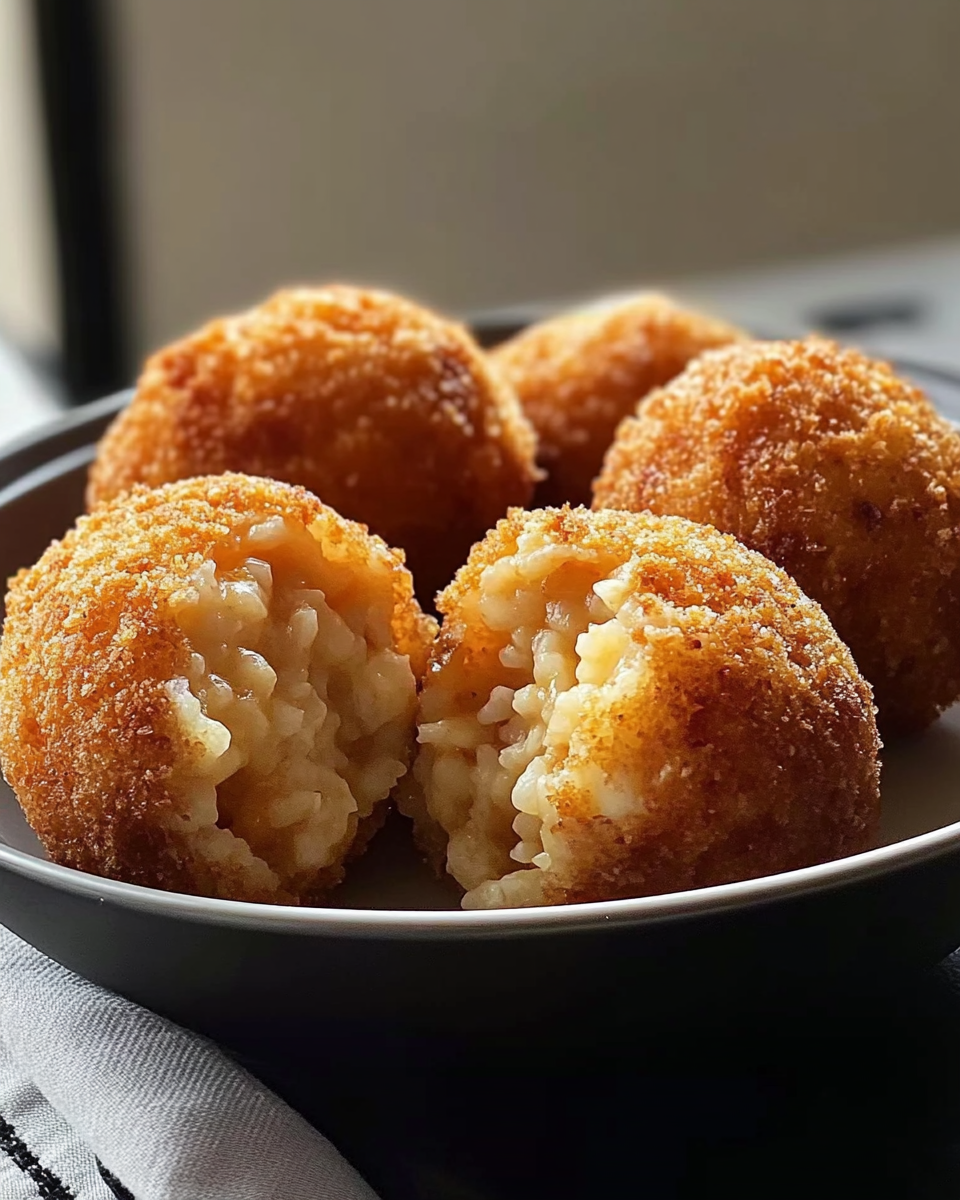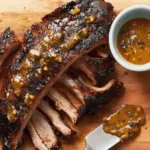Arancini are the perfect harmony of textures—the crispy, golden crust gives way to a luscious, creamy risotto center with a gooey mozzarella surprise. This traditional Sicilian street food turns simple leftover risotto into an irresistible finger food, ideal for sharing or as a comforting snack.
Beyond their deliciousness, arancini bring a bit of Italian charm to your table. Their crispy coating and cheesy filling pair beautifully with a tangy marinara sauce, making them a crowd-pleaser at parties or an indulgent treat for a casual meal. Plus, they’re surprisingly easy to prepare, turning everyday ingredients into an elegant bite-sized delight.
Full recipe:
Ingredients:
-
2 cups cooked risotto (preferably cooled)
-
1/2 cup shredded mozzarella cheese
-
1/4 cup grated Parmesan cheese
-
2 eggs, beaten
-
1 cup all-purpose flour
-
1 1/2 cups Italian-style breadcrumbs
-
Vegetable oil, for frying
-
Salt and pepper, to taste
-
Marinara sauce, for serving (optional)
Directions:
-
Take a small handful of the cooled risotto and flatten it in your palm.
-
Place a small amount of shredded mozzarella in the center, then shape the risotto around the cheese to form a ball about the size of a golf ball. Repeat with remaining risotto and cheese.
-
Set up a breading station with three bowls: flour in the first, beaten eggs in the second, and breadcrumbs in the third.
-
Roll each risotto ball in flour, then dip into the eggs, and finally coat thoroughly with breadcrumbs.
-
Heat vegetable oil in a deep skillet or fryer to 350°F (175°C).
-
Fry the arancini in batches, turning occasionally, until golden brown and crispy, about 3-4 minutes.
-
Remove with a slotted spoon and drain on paper towels.
-
Serve hot with marinara sauce on the side for dipping if desired.
Prep Time: 20 minutes | Cooking Time: 15 minutes | Total Time: 35 minutes
Kcal: Approximately 220 kcal per arancini | Servings: 4 servings (about 12 arancini)
Historical and Cultural Background
The origins of arancini date back to the Middle Ages, when Sicilian cuisine was influenced by a blend of Arabic, Norman, and Spanish cultures. Rice was introduced to Sicily during Arab rule, and the locals combined this ingredient with their existing culinary traditions. Arancini were initially created as a portable, hearty meal for workers and travelers—easy to carry and deliciously satisfying.
In Sicilian households, arancini are often associated with celebrations and holidays, particularly the Feast of Santa Lucia on December 13th. Traditionally, families gather to prepare arancini together, passing down recipes through generations, preserving a sense of community and heritage.
Key Characteristics of Arancini
What sets arancini apart from other fried snacks is their unique texture and flavor contrast. The outside is crisp and golden brown, thanks to the breadcrumb coating and deep-frying technique. Inside, the risotto is soft, creamy, and richly flavored, often mixed with Parmesan cheese and sometimes infused with saffron or herbs. The center hides a molten core of mozzarella cheese that melts when fried, creating a delightful surprise for anyone biting into them.
Arancini can vary widely depending on the region or family recipe. Classic versions often contain a ragù (meat sauce) filling, peas, or ham, but the basic risotto-and-cheese combination is the most universally recognized.
The Art of Making Perfect Arancini
Making arancini requires a careful balance of cooking and technique. The risotto base needs to be prepared just right—not too wet, so the balls hold their shape, but creamy enough to remain tender inside. Many cooks use leftover risotto for this reason, which makes the recipe an excellent way to reduce food waste.
The breading process involves three steps: coating the formed balls first in flour, then beaten eggs, and finally breadcrumbs. This triple coating is essential for achieving the ideal crispy exterior. When frying, maintaining the oil at a steady temperature (around 350°F or 175°C) ensures the arancini cook evenly and develop that perfect crunch without absorbing excess oil.
Variations and Modern Twists
While the traditional cheese-stuffed arancini remain a favorite, chefs and home cooks have experimented extensively with fillings and flavors. Some popular variations include:
-
Meat-filled arancini: Incorporating a slow-cooked ragù with peas and sometimes mozzarella.
-
Vegetarian options: Stuffed with mushrooms, spinach, or roasted vegetables.
-
Seafood versions: Using tuna, shrimp, or other seafood blended into the risotto or as a filling.
-
Herb and spice infusions: Adding saffron, basil, or chili flakes for enhanced flavor.
-
Fusion recipes: Using non-Italian ingredients such as curry spices or Asian-inspired fillings.
These innovations showcase arancini’s versatility and appeal to diverse palates while respecting their roots.
Nutritional Perspective
Arancini are undeniably indulgent, given the frying process and cheese content, but they can be enjoyed as part of a balanced diet. The risotto base offers carbohydrates and protein from rice and cheese, while the breading and frying add fats that provide satiety and rich flavor.
To make a lighter version, some cooks bake arancini instead of frying, or use air fryers for a crisp result with less oil. Using whole-grain breadcrumbs and lower-fat cheeses can also improve the nutritional profile without sacrificing much flavor.
Serving Suggestions and Pairings
Arancini are often served as appetizers or finger foods but can easily be a satisfying main dish with the right accompaniments. The classic way is to serve them hot with a side of marinara or tomato sauce, which adds acidity and freshness that balances the richness of the fried rice balls.
Pairing arancini with a simple green salad or roasted vegetables creates a well-rounded meal. For beverages, traditional Sicilian wines such as Nero d’Avola or a crisp white like Grillo complement the flavors beautifully.
Arancini in Contemporary Food Culture
Thanks to globalization and the rise of food media, arancini have gained popularity far beyond Italy. They are now staples in Italian restaurants worldwide and frequently appear in food festivals and cooking shows.
Food bloggers and chefs often highlight arancini for their photogenic golden crust and gooey cheese pull, making them popular on social media platforms. The dish’s hand-held size and customizable fillings make it a favorite for casual gatherings, catering, and even gourmet dining experiences.
Tips for Home Cooks
If you want to try making arancini at home, here are a few tips to ensure success:
-
Use day-old risotto for the best consistency.
-
Chill the formed balls before frying to prevent them from falling apart.
-
Do not overcrowd the frying pan; fry in small batches.
-
Drain on paper towels to remove excess oil.
-
Experiment with fillings to find your favorite combination.
-
Serve immediately while hot for the best taste and texture.
Conclusion: Why Arancini Deserve a Place on Your Table
Arancini offer a wonderful mix of tradition, flavor, and fun that makes them a must-try for anyone interested in authentic Italian cuisine. Their history as a street food that transformed into a gourmet favorite shows the power of simple ingredients combined with care and creativity.
Whether enjoyed at a family gathering, a party, or as a comforting snack, arancini deliver joy with every bite. The crispy exterior, the creamy risotto, and the melting cheese center create a satisfying experience that’s both nostalgic and timeless. Making arancini at home can also be a joyful culinary adventure, connecting you with centuries of Sicilian food heritage.
Add arancini to your repertoire and enjoy this golden, cheesy delight that continues to capture hearts worldwide.






